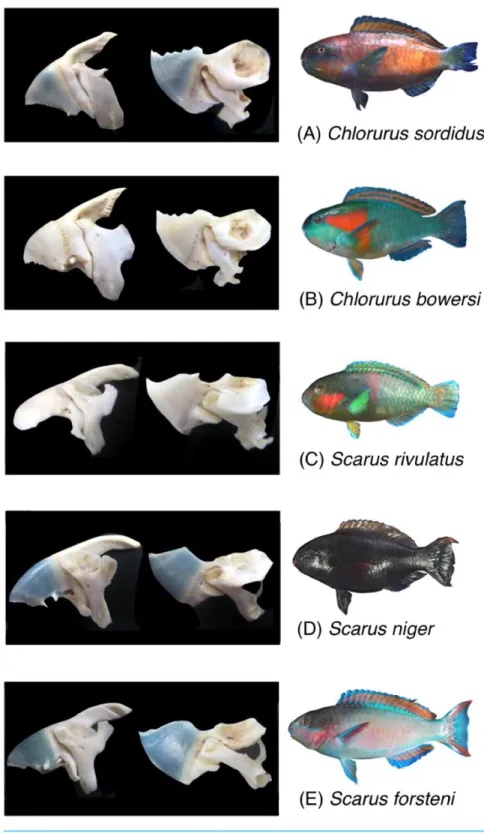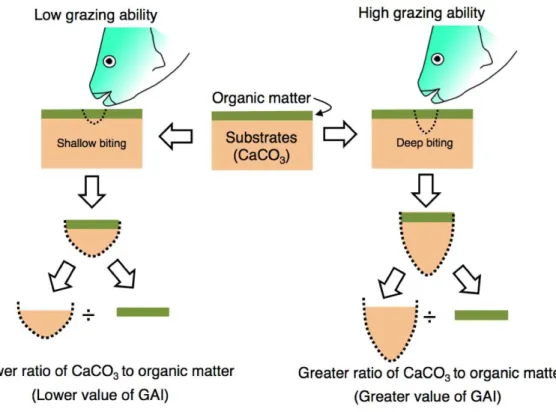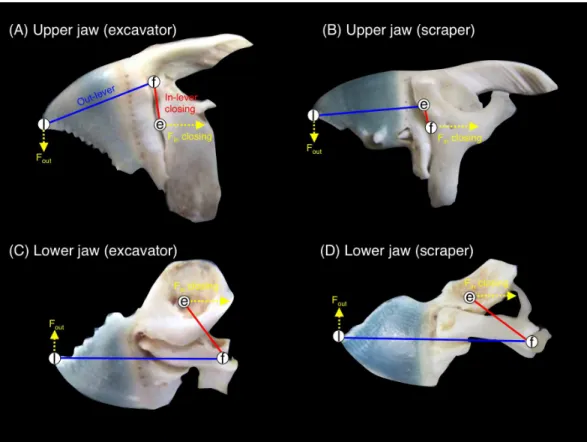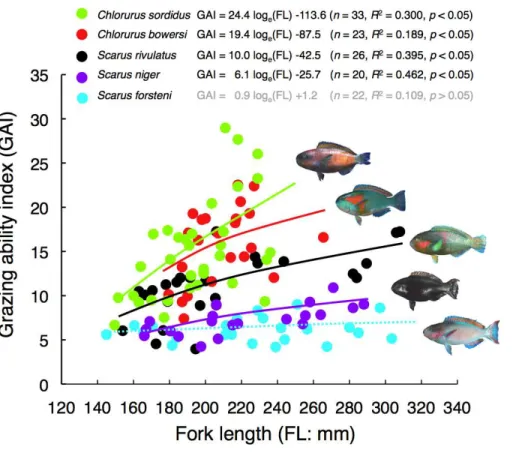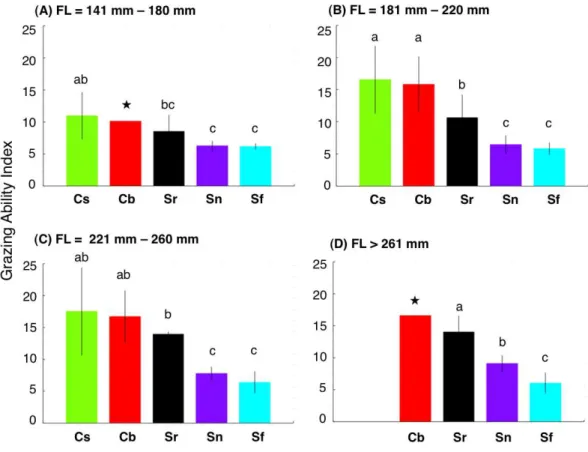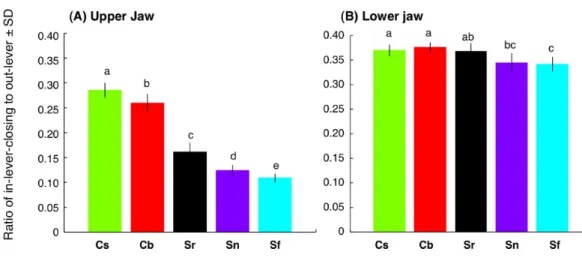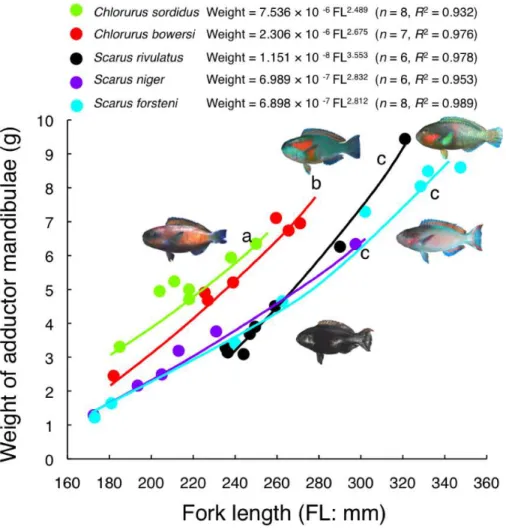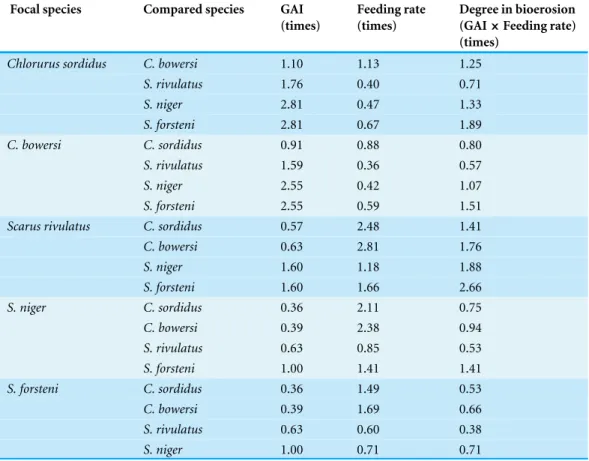Submitted17 May 2016 Accepted 9 August 2016 Published1 September 2016 Corresponding author Atsushi Nanami, nanami@fra.affrc.go.jp
Academic editor John Ringo
Additional Information and Declarations can be found on page 15
DOI10.7717/peerj.2425
Copyright 2016 Nanami
Distributed under
Creative Commons CC-BY 4.0 OPEN ACCESS
Parrotfish grazing ability: interspecific
differences in relation to jaw-lever
mechanics and relative weight of
adductor mandibulae on an Okinawan
coral reef
Atsushi Nanami
Research Center of Sub-tropical Fisheries, Seikai National Fisheries Research Institute, Japan Fisheries Research and Education Agency, Ishigaki, Okinawa, Japan
ABSTRACT
Parrotfishes (family Labridae: Scarini) are regarded to have important roles for maintaining the ecosystem balance in coral reefs due to their removal of organic matter and calcic substrates by grazing. The purpose of the present study was to clarify the interspecific differences in grazing ability of five parrotfish species (Chlorurus sordidus,C. bowersi,Scarus rivulatus,S. nigerandS. forsteni) in relation to interspecific differences in jaw-lever mechanics and the relative weight of the adductor mandibulae (muscles operating jaw closing). The grazing ability was calculated by using stomach contents (CaCO3 weight/organic matter weight) defined as the grazing ability index (GAI). There were significant interspecific differences in GAI (C. sordidus=C. bowersi > S. rivulatus > S. niger = S. forsteni). Teeth of C. sordidus and C. bowersi were protrusive-shape whereas teeth ofS. rivulatus,S. niger andS. forsteniwere flat-shape. C. sordidusandC. bowersihave jaw-lever mechanics producing a greater biting force and have a larger weight of adductor mandibulae.S. rivulatushas jaw-lever mechanics producing a greater biting force but a smaller weight of adductor mandibulae that produce an intermediate biting force. In contrast,S. niger andS. forsteni have jaw-lever mechanics producing a lesser biting force and have a smaller weight of adductor mandibulae. Feeding rates and foray size ofS. rivulatus,S. niger andS. forsteni were greater than C. sordidusandC. bowersi. The degree in bioerosion (GAI×feeding rate) was the largest forS. rivulatusand the smallest forS. forsteni. The degree in bioerosion for C. sordidus was larger thanS. niger whereas relatively equal between C. bowersi andS. niger. These results suggest that interspecific difference in GAI was explained by interspecific differences in teeth shape, jaw-lever mechanics and relative weight of adductor mandibulae. The interspecific difference in the degree of bioerosion suggests the importance of various size of parrotfishes with diverse feeding modes to maintain healthy coral reef ecosystems.
SubjectsEcology, Marine Biology, Zoology
INTRODUCTION
Coral reefs support high species diversity of marine organisms including fishes. Among the diverse species of coral reef fishes, parrotfishes (family Labridae: Scarini) are considered to be important components to maintain a healthy coral reef ecosystem in relation to their feeding mode (reviewed inBonaldo, Hoey & Bellwood, 2014). Parrotfishes are considered to contribute to the enhancement of settlement of benthic organisms including corals by removing epilithic algae and benthic organisms on the substrates by gazing (Mumby et al., 2006;Adams et al., 2011but also seeRuss et al., 2015). Parrotfishes are also considered to contribute to the bioerosion of coral reefs which is an important process to build coral reef environments (Bellwood, 1995a;Bellwood, 1995b). A decrease in parrotfish density due to human activities would subsequently cause dramatic change in the ecosystem balance and resilience of coral reefs (Bellwood et al., 2004;Bellwood, Hoey & Hughes, 2011; Hughes et al., 2007).
Bellwood & Choat (1990)categorized parrotfishes into two functional groups based on the morphological characteristics of jaws (premaxilla, maxilla, dentary and articular). The first group is formed of excavators that have a deep shape and a thick cement covering of jaws. Feeding behavior of excavators shows a short powerful bite and the degree of grazing was greater, which was found by their bite marks termed as scars (Bellwood, 1995a;Bellwood, 1995b;Bellwood, 1996;Alwany, Thaler & Stachowitsch, 2009;Bonaldo & Bellwood, 2009). Excavators mainly consist of genusBolbometopon,Cetoscarus,Chlorurusand some Spari-somaspecies (Bellwood & Choat, 1990;Bellwood, 1994). The second group is formed of scrapers that have a shallow shape and thin cement covering of jaws. Scrapers deliver weaker bites and graze less, per bite unit, than excavators (Lokrantz et al., 2008;Bonaldo, Krajewski & Bellwood, 2011). Scrapers mainly consist of the genusScarus and several Sparisomaspecies (Bellwood & Choat, 1990;Bellwood, 1994).
Some previous studies have estimated the grazing ability of parrotfishes by observation of scars (Bellwood, 1995a;Bellwood, 1995b;Bellwood, 1996;Van Rooij, Videler & Bruggemann, 1998;Alwany, Thaler & Stachowitsch, 2009;Bonaldo & Bellwood, 2009;Bonaldo, Krajewski & Bellwood, 2011). Scars are found when parrotfishes graze the substrates for feeding and the characteristics of the scars were different between excavators and scrapers in relation to their jaw morphology (e.g.,Alwany, Thaler & Stachowitsch, 2009;Bonaldo & Bellwood, 2008; Bonaldo & Bellwood, 2009; Lokrantz et al., 2008; Bonaldo, Krajewski & Bellwood, 2011). These studies measured the size of scars (depth×width×length) for quantitative estimations of the grazing ability and showed that the size of scars was greater for excavators than scrapers (Hoey & Bellwood, 2008;Lokrantz et al., 2008;Bonaldo & Bellwood, 2009). Several studies have also shown that the larger size of scars was found for larger size of individuals, indicating the ontogenetic difference in grazing ability of parrotfishes (Bruggemann et al., 1996;Bonaldo & Bellwood, 2008;Lokrantz et al., 2008).
graze on the carbonate substrates and removed only epilithic algae, whereas larger-sized individuals (over 15 cm in fork length) ingested the calcium carbonate substrates during grazing events. Thus, Bruggemann et al. (1996)also showed that the feeding mode and body size are good indicators of the degree of grazing ability of parrotfishes.
Although parrotfishes are major fish assemblage components in Okinawan coral reefs, ecological studies on grazing and bioerosion focusing on interspecific differences in jaw-lever mechanics and relative weight of adductor mandibulae (muscle operating jaw closing) have not been clarified yet in this region (Bonaldo, Hoey & Bellwood, 2014). In addition, although jaw-lever mechanics and relative weight of adductor mandibulae are the key aspects to clarify the feeding ecology of marine fishes, quantitative comparisons of interspecific differences in jaw-lever mechanics and relative weight of adductor mandibulae have not been sufficiently examined for multiple species of parrotfishes.
The aims of the present study were to investigate the grazing ability of five species of parrotfishes in an Okinawan coral reef. Specifically, the aims were to clarify (1) interspecific differences in grazing ability, (2) ontogenetic variations in grazing ability, (3) a quantitative description of jaw-lever mechanics, (4) an interspecific comparison in relative adductor mandibulae weight to parrotfish size and (5) the feeding behavior of parrotfishes in this region.
MATERIALS AND METHODS
The study was conducted mainly using field observations of free-living fishes in their natural habitat. Individuals caught for sampling were immediately killed by placing them on ice to minimize pain. The sampling procedure was approved by Okinawa prefectural government fisheries coordination regulation No. 41, which permits capture of marine fishes on Okinawan coral reefs for scientific purposes.
Study species
Five parrotfish species were selected for the present study (Chlorurus sordidus,C. bowersi, Scarus rivulatus,S. niger andS. forsteni) (Fig. 1). These five species are commonly found in Okinawa.
Estimation of grazing ability using stomach contents
The grazing ability of parrotfish was estimated from stomach contents as follows. Since the substrate of coral reefs consists of limestone, the stomach contents of parrotfish can be considered to contain the calcium carbonate (CaCO3). Namely, the stomach contents can be regarded as mixtures of organic matter (e.g., epilithic algae) and CaCO3(stomach contents=organic matter+CaCO3) (Fig. 2). In the present study, it was considered that
the ratio of CaCO3in the stomach contents would be higher if the grazing ability is greater (i.e., deep biting,Fig. 2). Therefore, the ratio (CaCO3weight/organic matter weight) is defined as the ‘‘grazing ability index’’ (GAI) in the present study.
The CaCO3weight was calculated as:
Figure 1 Photographs of the five parrotfish species with their upper jaw lever-system (premaxilla+
Figure 2 Schematic diagram of the definition of grazing ability index (GAI).Substrates consist of calcium carbonate (CaCO3)and are covered by organic matter (epilithic algae, sensuBellwood & Choat,
1990). The ratio of CaCO3weight to organic matter weight would change with the difference in grazing
ability. For measurement procedures of the CaCO3weight and organic matter weight, see ‘Materials and
Methods’.
CaCO3 can be removed from the stomach contents by adding hydrochloric acid (HCl) aqueous solution as the following reaction formula:
CaCO3+2HCl⇒CaCl2+H2O+CO2
where CaCl2is calcium chloride, H2O is water and CO2is carbon dioxide. Since CaCl2is water-soluble and CO2isvolatile, the CaCO3as well as CaCl2and CO2were completely removed from the stomach contents by water rinsing. Then, the ratio of CaCO3to organic matter weight (i.e., GAI) was calculated as:
GAI=(dry weight of CaCO3)/(dry weight of organic matter)
= [dry weight of(stomach content−organic matter)]/[(dry weight of organic matter)].
Thus, the GAI represents the CaCO3weight that was simultaneously grazed per unit of weight of organic matter on substrate.
Sampling and experimental procedure
149.5–236.0 mm),C. bowersi(n=23: 179.5–265.5 mm),S. rivulatus(n=26: 154.0 mm–
319.5 mm),S. niger (n=20: 166.0–288.0 mm) andS. forsteni(n=22: 145.0–303.5 mm). All fishes were collected by spearing the head and immediately killed in an icebox to minimize any loss of stomach contents.
Dry weight in the stomach contents and organic matter were determined as follows: (1) a subsample of stomach contents (c.a. 3 g in wet weight) was put into a 1.5 ml microtube and dried at 58 ◦C; (2) the weight of the dried stomach contents was measured to the nearest 0.0001 g; (3) 1N-HCl aqueous solution was poured onto the stomach contents; (4) the microtube was centrifuged and supernatant HCl aqueous solution was removed using micro-pipet with care not to remove any stomach contents; (5) the third and fourth procedures were repeated until no CO2bubbles were found during the third procedure; (6) the remaining stomach contents were rinsed using distilled water, centrifuged and the supernatant water was removed. Finally, the organic matter (stomach contents with no CaCO3) was dried at 58◦C and the weight was measured to the nearest 0.0001 g.
Interspecific comparison in GAI
The relationships between FL and GAI were plotted as a logarithmic function as:
GAI=aloge(FL)+b
where a and b are coefficients. One-way ANOVA was conducted for interspecific comparisons of GAI for four FL ranges with 40-mm intervals: (1) 140.0 mm–180.0 mm, (2) 180.5 mm–220.0 mm, (3) 220.5 mm–260.0 mm and (4) over 260.5 mm. If a significant difference was found, a post-hoc Games-Howell test was applied for multiple comparisons among the five species.
Teeth characteristics
Number of teeth on dental plates for premaxilla and dentary was counted. A total of 10 samples were used for each species. One-way ANOVA and post-hoc Games-Howell test was used for significant differences in the ratio among the five species.
Jaw-lever mechanics for closing
Figure 3 Pictorial explanation of the jaw-lever mechanics for closing (e, effort; f, fulcrum; l, load. See alsoFig. S1).(A) upper jaw of excavator (Chlorurus sordidus); (B) upper jaw of scraper (Scarus forsteni); (C) lower jaw of excavator (Chlorurus sordidus); (D) lower jaw of scraper (Scarus forsteni). The relative difference in biting force and velocity can be estimated by measuring the length of the in-lever-closing (red lines: Lin-lever-closing) and out-lever (blue lines: Lout-lever). The ratio of in-lever-closing to out-lever
(Lin-lever-closing/ Lout-lever) can be calculated in accordance withWainwright & Bellwood (2002),Westneat
(2004)andWestneat et al. (2005). The greater values in the ratio means greater biting force but lower velocity in biting and vice versa. Fin-closing: force for jaw closing at tendon (see alsoFig. S1). Fout: produced
force for jaw rotation.
Muscles operating the jaw
Weight of muscles operating jaw (adductor mandibulae) was measured nearest 0.01 g by dissecting. The relationship between FL and adductor mandibulae weight was plotted as a power function as:
adductor mandibulae weight=aFLb
Underwater observations of feeding behavior
Feeding behavior was observed at the fringing reef around Ishigaki Island between October and November 2011 and between October 2012 and February 2013. Underwater observations were conducted at the reef slope (fore reef) using SCUBA equipment or snorkeling. Depth range was 3 m–5 m and water temperature was 22◦C–28◦C. A researcher (A Nanami) searched for individuals of the focal species and followed a focal individual paying particular attention not to disturb the behavior of the individual. To avoid double-counts for the focal individual, species, size and/or sex were changed for the subsequent observations. The estimated FL (cm), number of bites per 5 min (feeding rate) and foray size (mean number of bites: sensuBellwood & Choat, 1990) were counted. The FL range was between 25 cm and 35 cm and time zone was between 1200 h–1600 h. Since previous studies have demonstrated a time-zone difference in feeding rates (e.g., 0800 h–1000 h, 1001 h– 1200 h, 1201 h–1400 h and 1401 h–1600 h;Bellwood, 1995a;Bonaldo & Bellwood, 2008), a one-way ANOVA was performed to clarify if any time-zone differences occurred in the feeding rates for the two time zones (1200 h–1400 h and 1401 h–1600 h). As a result, no significant time-zone differences were found for all five species. Thus, the feeding rates obtained in the two time zones were pooled and used for further analyses. The numbers of individuals were 10, 11, 11, 7 and 8 for Chlorurus sordidus,C. bowersi,Scarus rivulatus, S. niger andS. forsteni, respectively. One-way ANOVA and a post-hoc Games-Howell test were applied for multiple comparison for feeding rates and foray size among the five species. During the observations of feeding behavior, the numbers of bites per substrate were also recorded. Previous studies have categorized the feeding substrates as epilithic algae on hard substrata, macroalgae, live coral, crustose coralline algae and seagrass (Rotjan & Lewis, 2005;Rotjan & Lewis, 2009;Hoey & Bellwood, 2008;Alwany, Thaler & Stachowitsch, 2009; Nash et al., 2012;Bonaldo, Hoey & Bellwood, 2014). The data for the respecting feeding substrates were represented as the proportion of the number of bites (%) for each substrate against the total number of bites. The proportions of bites for each individual were averaged for each species.
Interspecific comparison in degree of bioerosion
From the data of GAI and feeding rates, the degree of bioerosion was calculated as follows:
degree of bioerosion=(GAI)×(feeding rate).
This was because the degree of bioerosion should be considered by both GAI and feeding rates. For calculation of the degree of bioerosion, calculated GAI data at 30 cm FL were obtained using the above-mentioned FL-GAI relationship. The rate of focal species to another species was calculated for all pairs of the five species for interspecific comparison of the degree of bioerosion.
RESULTS
Interspecific difference in GAI
Figure 4 Relationships between fork length (FL) and grazing ability index (GAI) for the five parrotfish species.The relationships are plotted by logarithmic function.
relationship between FL and GAI was found forS. forsteni, it was not significant (Fig. 4). Overall, the GAIs were greater forC. sordidusandC. bowersi, intermediate forS. rivulatus and lesser forS. nigerandS. forsteni(Fig. 5). For the 141 mm–180 mm FL range, the GAI of C. sordiduswas significantly greater thanS. niger andS. forsteni (Games-Howell test, p<0.05) (Fig. 5A). For the 181–220 mm FL range, GAIs ofC. sordidusandC. bowersiwere significantly greater than the other three species (Fig. 5B). The GAI ofS. rivulatuswas also significantly greater thanS. niger andS. forsteni(Fig. 5B). For the 221 mm–260 mm FL range, the GAIs forC. sordidus,C. bowersiand S.rivulatuswere significantly greater than S. niger andS. forsteni(Fig. 5C). For the over 260 mm FL range, significant differences in GAI were found amongS. rivulatus,S. niger andS. forsteni(Fig. 5D).
Interspecific differences in teeth characteristics
Figure 5 Interspecific difference in grazing ability index (GAI) for four fork length (FL) ranges.The different alphabet characters on the bars indicate the significant difference in GAI (Games-Howell test, p<0.05). Vertical lines represent standard deviation. Star symbols in (A) and (D): only 1 individual for Chlorurus bowersiand excluded from Games-Howell test due to no standard deviations. No individuals forC. sordidusin (d). Species names are abbreviated as Cs,Chlorurus sordidus; Cb,C. bowersi; Sr,Scarus rivulatus; Sn,S. niger; Sf,S. forsteni.
Interspecific differences in jaw-lever mechanics for closing
For the upper jaw, the ratio of in-lever-closing to out-lever (Lin-lever-closing/Lout) was significantly different among the five species (C. sordidus>C. bowersi>S. rivulatus> S. niger >S. forsteni) (Fig. 7A) (one-way ANOVA and post-hoc Games-Howell test, p<0.05). For the lower jaw, the ratio of in-lever-closing to out-lever (Lin-lever-closing/Lout) forC. sordidusandC. bowersiwas significantly greater thanS. nigerandS. forsteni(Fig. 7B). No significant difference in the ratio was found among C. sordidus,C. bowersiandS. rivulatusand betweenS. rivulatusandS. niger (Fig. 7B).
Interspecific difference in relationship between FL and adductor mandibulae weight
Figure 6 Photographs of teeth on dental plates of premaxilla (A) and dentary (B). Number of teeth on dental plates of premaxilla (C) and dentary (D). Different alphabet characters on the bars indicate signifi-cant difference (one-way ANOVA and post-hoc Games-Howell test,p<0.05). Species names are abbrevi-ated as Cs,Chlorurus sordidus; Cb,C. bowersi; Sr,Scarus rivulatus; Sn, S.niger; Sf,S. forsteni.
Figure 7 Interspecific difference in the ratio of in-lever-closing to out-lever (Lin-lever-closing/ Lout-lever) (see
Figure 8 Relationship between fork length and weight of adductor mandibulae for the five parrotfish species.Different alphabet characters near the regression lines indicate significant difference (ANCOVA and post-hoc Bonferroni test,p<0.05).
Feeding behavior
Feeding rates forScarus rivulatus,S. nigerandS. forstenitended to be higher thanC. sordidus andC. bowersi(Table 1). The feeding rates ofS. rivulatusandS. niger were significantly higher thanC. sordidusandC. bowersi(one-way ANOVA and post-hoc Games-Howell test, p<0.05). A similar tendency was found for foray size (Table 1). The foray size ofS. rivulatus andS. niger were significantly larger thanC. sordidusandC. bowersi(one-way ANOVA and post-hoc Games-Howell test,p<0.05). The main feeding substrate was epilithic algae on hard substrates such as rocks and dead coral skeletons. No individuals were observed feeding on macroalgae, crustose coralline algae or seagrass in the present study. Live coral were rarely fed on byC. bowersiandS. niger (Table 1).C. sordidus,S. rivulatusand S. forstenidid not feed on live coral.
Interspecific comparison in degree of bioerosion
Table 1 Interspecific difference in feeding rate, foray size and location of feeding.For feeding rate and foray size, different alphabet characters attached on the numbers indicate significant differences among species (one-way ANOVA and post-hoc Games-Howell test,p<0.05).
Species n Feeding rates (5 min−1) Foray size Proportion of bites (%)
±SD ±SD Epilithic algae Live coral
Chlorurus sordidus 10 75.0±31.7ab 6.3±2.1ac 100 0
C. bowersi 11 66.3±29.0ab 6.1±3.5ac 99.8 0.2
Scarus rivulatus 11 186.0±50.7c 15.8±7.8b 100 0
S. niger 7 158.0±53.3cd 15.9±4.6b 98.3 1.7
S. forsteni 8 111.8±37.9bd 9.2±4.7bc 100 0
Notes.
SD, Standard deviation.
Table 2 Interspecific comparison of the degree of bioerosion among the five parrotfish species repre-sented by rates of focal species to another species.
Focal species Compared species GAI
(times)
Feeding rate (times)
Degree in bioerosion
(GAI×Feeding rate)
(times)
Chlorurus sordidus C. bowersi 1.10 1.13 1.25 S. rivulatus 1.76 0.40 0.71
S. niger 2.81 0.47 1.33
S. forsteni 2.81 0.67 1.89
C. bowersi C. sordidus 0.91 0.88 0.80
S. rivulatus 1.59 0.36 0.57
S. niger 2.55 0.42 1.07
S. forsteni 2.55 0.59 1.51
Scarus rivulatus C. sordidus 0.57 2.48 1.41
C. bowersi 0.63 2.81 1.76
S. niger 1.60 1.18 1.88
S. forsteni 1.60 1.66 2.66
S. niger C. sordidus 0.36 2.11 0.75
C. bowersi 0.39 2.38 0.94
S. rivulatus 0.63 0.85 0.53
S. forsteni 1.00 1.41 1.41
S. forsteni C. sordidus 0.36 1.49 0.53
C. bowersi 0.39 1.69 0.66
S. rivulatus 0.63 0.60 0.38
S. niger 1.00 0.71 0.71
Notes.
GAI, Grazing ability index.
DISCUSSION
Grazing ability index (GAI) to estimate interspecific difference in grazing ability
The present study is the first trial to design a new index of parrotfish grazing ability using stomach contents and to estimate interspecific differences in grazing ability among multiple parrotfish species using the new index. The GAI can be considered as an indicator to enable comparison of the interspecific difference in grazing ability among multiple parrotfish species.
Interspecific difference in GAI in relation to jaw-lever mechanics
This study is the first study to estimate parrotfish grazing ability in an Okinawan coral reef. Furthermore, although the grazing abilities ofChlorurus sordidus,Scarus rivulatusand S. niger were estimated by previous studies in the Great Barrier Reef and the Red Sea (e.g., Lokrantz et al., 2008;Bonaldo & Bellwood, 2008;Alwany, Thaler & Stachowitsch, 2009), the grazing abilities forC. bowersiandS. forsteniare first estimated in the present study. The present study also showed the degree of increase in GAI with FL was different among the species. It is suggested that the interspecific differences in GAI among the five species was explained by the interspecific differences in jaw-lever mechanics and relative weight of the adductor mandibulae. Two excavator species (C. sordidusandC. bowersi) have protrusive-shape teeth and jaw-lever mechanics that produce a greater biting force for both upper and lower jaws than the other three species (S. rivulatus,S. niger andS. forsteni). These two species also showed greater weight of adductor mandibulae, contributing to produce a greater biting force. As a result, the GAI would increase with the increase in FL. In contrast, two scraper species (S. nigerandS. forsteni) have flat-shape teeth and jaw-lever mechanics producing a lower biting force for both upper and lower jaws as well as smaller weight of adductor mandibulae. Consequently, GAI of the two species would be smaller than the other three species (C. sordidus,C. bowersi andS. rivulatus) and GAI would not dramatically increase despite the increase in FL. The present study firstly demonstrated that GAI ofS. rivulatuswas greater than the other two scraper species (S. nigerandS. forsteni), althoughS. rivulatusis categorized into scrapers (Bellwood & Choat, 1990).S. rivulatus has jaw-lever mechanics for upper jaws that produces the larger biting force among the three scraper species. Although jaw-lever mechanics for the lower jaw was not significantly different amongC. sordidus,C. bowersiandS. rivulatus, the relative weight of adductor mandibulae was significantly less among these three species. Thus, it is suggested that S. rivulatusproduce an intermediate biting force among the five species. Since the genus Scarusconsists of 18 species in Okinawa and have various morphological characteristics (Nakabo, 2000), interspecific differences in GAI in further multiple species should be conducted in the future study.
Interspecific comparison in feeding behavior and degree of bioerosion
indicating that the feeding rates and foray size for scrapers was greater than excavators (reviewed inBonaldo, Hoey & Bellwood, 2014). Among the scrapers, the feeding rates and foray size forS. forsteniwas smaller than the other two species. The present study estimated the interspecific difference in degree of bioerosion using GAI and feeding rate. Overall, the degree of bioerosion forS. rivulatuswas the greatest and the smallest forS. forsteni. The degree of bioerosion ofC. sordiduswas greater than forS. niger whereas almost the same betweenC. bowersiandS. niger. These results suggest that although the GAI was lower for scrapers, scrapers showed greater feeding rates and as a consequence, degree of bioerosion would be greater than excavators in some cases (e.g.,S. rivulatusin the present study).
The results of the present study suggest the importance of various sizes of parrotfishes with diverse feeding modes. Smaller-sized individuals would contribute to the removal of organic matter (e.g., epilithic algae) on the substrates in a less destructive manner. In contrast, larger-sized individuals, especially for excavators, would contribute to the removal of both organic matter and calcic substrates in a more destructive manner. In some cases such asS. rivulatus, which has an intermediate GAI and higher feeding rate, would more effective contribution to bioerosion. Since it has been suggested that increased fishing pressure leads to a decrease in the mean size of parrotfishes (Vallès & Oxenford, 2014; Vallès, Gill & Oxenford, 2015), effective protection of various sizes as well as the various species of parrotfish on reefs should be conducted to maintain a healthy ecosystem balance and resilience in coral reefs.
ACKNOWLEDGEMENTS
I express my grateful thanks to K Kinjo and M Sunagawa for their field guide and piloting the research boat YAEYAMA, B Watanabe, J Okuyama and T Sagawa for assistances in the field, S Mamiya for assistance in laboratory works and the staff of Research Center of Sub-tropical Fisheries, Seikai National Fisheries Research Institute for support during the present study. Comments from two anonymous reviewers and English grammar correction by CP Norman were much appreciated. The present study complies with current laws in Japan.
ADDITIONAL INFORMATION AND DECLARATIONS
Funding
This study was partly supported by the Japanese government subsidy related to Okinawa Promotion. The funders had no role in study design, data collection and analysis, decision to publish, or preparation of the manuscript.
Grant Disclosures
The following grant information was disclosed by the author: Japanese government subsidy related to Okinawa Promotion.
Competing Interests
Author Contributions
• Atsushi Nanami conceived and designed the experiments, performed the experiments,
analyzed the data, contributed reagents/materials/analysis tools, wrote the paper, prepared figures and/or tables, reviewed drafts of the paper.
Animal Ethics
The following information was supplied relating to ethical approvals (i.e., approving body and any reference numbers):
The study was conducted mainly using field observations of free-living fishes in their natural habitat. Individuals caught for sampling were immediately killed by placing them on ice in order to minimize pain.
Field Study Permissions
The following information was supplied relating to field study approvals (i.e., approving body and any reference numbers):
The sampling procedure was approved by Okinawa prefectural government fisheries coordination regulation No. 41, which permits capture of marine fishes on Okinawan coral reefs for scientific purposes.
Data Availability
The following information was supplied regarding data availability: The raw data has been supplied asSupplemental Files.
Supplemental Information
Supplemental information for this article can be found online athttp://dx.doi.org/10.7717/ peerj.2425#supplemental-information.
REFERENCES
Adams TC, Schmitt R, Holbrook SJ, Brooks AJ, Edmunds PJ, Carpenter RC, Bermardi G. 2011.Herbivory, connectivity, and ecosystem resilience: response of coral reef to a large-scale perturbation.PLoS ONE6:e23717DOI 10.1371/journal.pone.0023717.
Alwany MA, Thaler E, Stachowitsch M. 2009.Parrotfish bioerosion on Egyptian red sea reefs.Journal of Experimental Marine Biology and Ecology 371:170–176
DOI 10.1016/j.jembe.2009.01.019.
Bellwood DR. 1994.A phylogenetic study of the parrotfishes: family Scaridae (Pisces: Labroidei), with a revision of genera.Records of the Australian Museum Supplement
20:1–86DOI 10.3853/j.0812-7387.20.1994.51.
Bellwood DR. 1995a.Direct estimate of bioerosion by two parrotfish species,Chlorurus gibbusandC. sordidus, on the Great Barrier Reef, Australia.Marine Biology
121:419–429DOI 10.1007/BF00349451.
Bellwood DR. 1996.Production and reworking of sediment by parrotfishes (family Scaridae) on the Great Barrier Reef, Australia.Marine Biology125:795–800
DOI 10.1007/BF00349262.
Bellwood DR, Choat H. 1990.A functional analysis of grazing in parrotfishes (family Scaridae): the ecological implications.Environmental Biology of Fishes28:189–214
DOI 10.1007/BF00751035.
Bellwood DR, Hoey AS, Hughes TP. 2011.Human activity selectively impacts the ecosystem roles of parrotfishes on coral reefs.Proceeding of the Royal Society B, Biological Sciences279:1621–1629.
Bellwood DR, Hughes TP, Folke C, Nystrom M. 2004.Confronting the coral reef crisis. Nature429:827–833DOI 10.1038/nature02691.
Bonaldo BM, Bellwood DR. 2008.Size-dependent variation in the functional role of the parrotfishScarus rivulatuson the Great Barrier Reef, Australia.Marine Ecology Progress Series360:237–244DOI 10.3354/meps07413.
Bonaldo BM, Bellwood DR. 2009.Dynamics of parrotfish grazing scars.Marine Biology
156:771–777DOI 10.1007/s00227-009-1129-x.
Bonaldo BM, Hoey AS, Bellwood DR. 2014.The ecosystem roles of parrotfishes on tropical reefs.Oceanography and Marine Biology52:81–132 DOI 10.1201/b17143-3.
Bonaldo RM, Krajewski JP, Bellwood DR. 2011.Relative impact of parrotfish grazing scars on massivePoritescorals at Lizard Island, Great Barrier Reef.Marine Ecology Progress Series423:223–233DOI 10.3354/meps08946.
Bruggemann JH, Van Kessel AM, Van Rooij JM, Breeman AM. 1996.Bioerosion and sediment ingestion by the Caribbean parrotfishScarus vetulaandSparisoma viride: implications of fish size, feeding mode and habitat use.Marine Ecology Progress Series
134:59–71DOI 10.3354/meps134059.
Hoey AS, Bellwood DR. 2008.Cross-shelf variation in the role of parrotfishes on the Great Barrier Reef.Coral Reefs27:37–47DOI 10.1007/s00338-007-0287-x.
Hughes TP, Rodrigues MJ, Bellwood DR, Ceccarelli D, Hoegh-Guldberg O, McCook L, Moltschaniwskyj N, Pratchett MS, Steneck RS, Willis B. 2007.Phase shifts, herbivory, and the resilience of coral reefs to climate change.Current Biology
17:360–365DOI 10.1016/j.cub.2006.12.049.
Lokrantz J, Nyström M, Thryesson M, Johansson C. 2008.The non-linear relationship between body size and function in parrotfishes.Coral Reefs27:967–974
DOI 10.1007/s00338-008-0394-3.
Mumby PJ, Dahlgren CP, Harborne AR, Kappel CV, Micheli F, Brumbaugh DR, Holmes KE, Mendes JM, Broad K, Sanchirico JN, Buch K, Box S, Stoffle RW, Gill AB. 2006.Fishing, trophic cascades, and the process of grazing on coral reefs.Science
311:98–101 DOI 10.1126/science.1121129.
Nakabo T. 2000.Fishes of Japan with pictorial keys to the species. 2nd edition. Tokyo: Tokai University.
Rotjan RD, Lewis SM. 2005.Selective predation by parrotfishes on the reef coralPorites astreoides.Marine Ecology Progress Series305:193–201DOI 10.3354/meps305193.
Rotjan RD, Lewis SM. 2009.Predators selectively graze reproductive structures in a clonal marine organism.Marine Biology 156:569–577
DOI 10.1007/s00227-008-1108-7.
Russ GR, Questel SLA, Rizzari JR, Alcala AC. 2015.The parrotfish-coral relationship: refuting the ubiquity of a prevailing paradigm.Marine Biology162:2029–2045
DOI 10.1007/s00227-015-2728-3.
Vallès H, Gill D, Oxenford HA. 2015.Parrotfish size as a useful indicator of fishing ef-fects in a small Caribbean Island.Coral Reefs34:789–801
DOI 10.1007/s00338-015-1295-x.
Vallès H, Oxenford HA. 2014.Parrotfish size: a simple yet useful alternative indicator of fishing effects on Caribbean reefs?PLoS ONE9:e86291
DOI 10.1371/journal.pone.0086291.
Van Rooij JM, Videler JJ, Bruggemann JH. 1998.High biomass and production but low energy transfer efficiency of Caribbean parrotfish: implications for trophic models of coral reefs.Journal of Fish Biology (supplement A)53:154–178.
Wainwright PC, Bellwood DR. 2002. Ecomorphology of feeding in coral reef fishes. In: Sale PF, ed.Coral reef fishes. San Diego: Academic, 33–55.
Westneat MW. 2004.Evolution of levers and linkages in the feeding mechanisms of fishes.Integrative and Comparative Biology44:378–389DOI 10.1093/icb/44.5.378.
